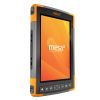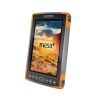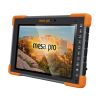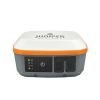Juniper Archer 4 Rugged Handheld Computers
Features
- 5G Cellular with 4G LTE fallback
- USB-C charging and data transfer
- Hot-swappable batteries
- Free ground shipping
- Expedited repair and warranty service
- Lifetime technical support
- More
Reliable Mobile Operating System
The Archer 4 runs on the Android 14 operating system and will support upgrades through Android 18, providing security and compatibility for years to come. The Archer 4 is also Google Mobile Services certified to provide users with a reliable platform for running popular data collection software.
Connectivity
The Archer 4 is a versatile communication device allowing you to stay connected to your network, the Cloud, or other devices. The processor chipset on every unit supports 5G cellular voice and data connectivity, Wi-Fi 6 compatibility, Class 1 Bluetooth 5.2 functionality, and provides dual-band GNSS location data.
All-day Usability
From its ergonomic enclosure to its sunlight-readable display, and down to its all-day battery life, the Archer 4 is built for long workdays wherever the job takes you.
Expandable
To meet the needs of any job, the capabilities of the Archer 4 can be enhanced with either modular barcode scanner or sub-meter GNSS expansion pods.
Battery
A choice of battery size means you can pack your Archer 4 with more power for a long day, or pop in the smaller battery for a more compact carrying setup. Hot-swapping batteries allows you to switch out a new battery without powering down the device and interrupting your workflow.
Built Juniper Rugged
At Juniper, they put their hardware through the wringer. Even after they meet IP68 and MIL-STD-810H standards for water, dust/debris and shock, they continue to test-to-fail so they know just how far users can push their devices. Rest assured rain, extreme temperatures, debris, and accidental drops or dunks won’t stop a productive workday with the Archer 4.
PROCESSOR
- Qualcomm® QCM4490 octa-core up to 2.4 GHz
OPERATING SYSTEM
- Operating system: Android™ 14
- GMS (Google Mobile Services) certified using EDLA
- Upgradeable through Android 18
STORAGE
- Memory (RAM): 8 GB
- Internal Storage (ROM): 128 GB
- SD Card Storage up to 512 GB
WIRELESS CONNECTIVITY
- 5G with 4G LTE fallback, Dual Nano SIM card slots
- Cellular: LTE-FDD: B1/B2/B3/B4/B5/B7/B8/B12/B13/B14/B20/
B25/B26/B28a/B66/B71, LTE-TDD: B38/B40/B41, 5G: N1, N2, N5, N41, N66, N71, N77, N78 - Wi-Fi®: 6E 802.11 2.4/5 GHZ a/b/g/n/ac, 802.11 ax
- Bluetooth® 5.2
- Dual-band GPS, GLONASS, Beidou, Galileo, QZSS
- NFC
- OTG
- USB Type-C (5Gbps, 5V power delivery)
JUNIPER RUGGED™
- Ingress protection: IP68 waterproof & dustproof
- Operating Temperature: -4 F to 140 F (-20 C to 60 C)
- Meets MIL-STD-810H test procedures: Method 500.6 Low Pressure, Method 501.7 High Temperature, 502.7 Low Temperature, 503.7 Temperature Shock, 506.6 Rain, 507.6 Humidity, 510.7 Sand and Dust, 512.6 Immersion, 514.8 Vibration, 516.8 Shock
PHYSICAL
- Weight: .72–.87 lbs (325–395 g) depending on battery and expansion configuration
- Dimensions with 4500 mAh battery: 174 x 85 x 15 mm
- Dimensions with 8300 mAh battery: 174 x 85 x 22 mm
- 2 user programmable buttons
DISPLAY
- 540 Nits typical
- Screen size (diagonal): 6.26”
- Screen resolution: 2280 x 1080 FHD+
- Capacitive multi-touch interface for wet conditions
- Chemically-strengthened Gorilla® Glass 5
- Optimized for extreme environments including wet touch
CAMERA
- Front: 16 MP
- Rear: 48 MP with LED illumination
EXPANSIONS
- Optional 1D/2D barcode add-on
- Sub-meter GNSS receiver (RTK capable)
BATTERY
- Removable Li-ion battery
- Battery size: 4500 mAh (standard) or 8300 mAh (optional upgrade)
- Internal 300 mAh battery allows for hot-swapping
CERTIFICATIONS AND STANDARDS
- IC/FCC/CE
- UKCA
- ROHS, REACH, REACH Restriction Article, EU POP, WEEE
- California Prop 65
- TSCA
- Bluetooth SIG
- RCM
- Japan Radio (TELEC, JATE)
- Brazil ANATEL
- SCIP
- Canada Prohibition
- ERP, CEC, DOE
- PTCRB
- Global Certification Forum (GCF)
- AT&T Network Approved
- Main unit
- Removable Lithium-Ion Battery
- Adjustable Hand Strap
- Hand Strap Loop and Screws
- T6 Torx Screwdriver
- Quick Start Guide
In The News
Research in the Reserve: Promoting Interdisciplinary Conservation at the Great Bay National Estuarine Research Reserve
On an early winter day in 1973, a helicopter buzzed over Durham, New Hampshire, just a few miles from the Atlantic Ocean. One of the helicopter’s guests, oil magnate Aristotle Onassis, owner of Olympic Refining, looked east of town and saw what he hoped would become the world’s largest oil refinery. Instead, he saw the Great Bay; thousands of acres of green coastal forest, mud flats, salt marshes, and estuarine tidal waters stretching over the land toward New Hampshire's small Eastern coastline. Onassis likely also saw a group of Durham residents staked out on the bay’s coast, ready for him to pass overhead. While out of place in the natural setting, an obvious message was spelled out in red paper: “Not Here.
Read MoreFloating Global New Ideas: Buoy-Enabled Research at Florida Agricultural and Mechanical University’s School of the Environment
Florida Agricultural and Mechanical University (FAMU), based in Tallahassee, Florida, is the highest-rated public Historically Black College or University in the United States. FAMU’s School of the Environment (FAMU-SOE) offers BS and BA degrees in Environmental Studies, and BS, MS, and Ph.D. degrees in Environmental Science, with specialisms available in areas including Environmental Policy and Risk Management, Aquatic and Terrestrial Ecology, and Biomolecular Sciences. In 2021, FAMU-SOE deployed a NexSens CB-450 buoy in Apalachee Bay, a key oyster farming area around 30 miles south of Tallahassee. The buoy has quickly been incorporated into the curriculum, providing environmental insights for student research, the community, and beyond. Dr.
Read MoreMonitoring Habitat Suitability and Water Quality in Northwest Arkansas Springs
Northwest Arkansas has seen an economic, industrial, and population boom in recent years as a result of expanding businesses, which have created thousands of jobs in the region and the mass migration of employees and construction companies. However, with this growth has come rapid urbanization and the degradation of the natural landscape, specifically the freshwater springs that can be found throughout the region. These springs are critical habitat centers for native wildlife, home to threatened and endangered fish, and those that have yet to be listed. Zach Moran, Assistant Professor of Fisheries Science at Arkansas Technical University, is working to help monitor these habitats and provide key data that will hopefully inform future development in the region.
Read More






















